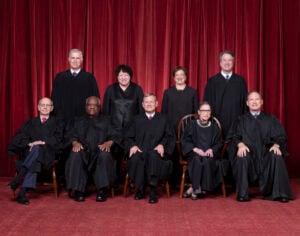The Supreme Court's Successful New Approach To Oral Argument
Let's hope that SCOTUS sticks with these reforms post-pandemic.

The Roberts Court, November 2018 (public domain – photograph by Fred Schilling, Supreme Court Curator’s Office).
The coronavirus pandemic is changing the legal profession — and it’s not all bad. Last month, for example, I identified four ways that Biglaw might benefit from the current crisis.
Courts have adopted measures in response to the COVID-19 outbreak as well. Most notably, the U.S. Supreme Court conducted its latest oral arguments by telephone — and livestreamed the proceedings, making real-time audio available for the first time in its history. Prior to the pandemic, SCOTUS didn’t release the recordings of oral arguments until the end of each week.

Early Adopters Of Legal AI Gaining Competitive Edge In Marketplace
A tradition-bound and precedent-based institution, the Court has historically been resistant to change, as well as a little uncomfortable with both technology and real-time coverage (especially video aka “cameras in the courtroom,” which Justice David Souter famously quipped would have to roll into the courtroom “over my dead body”). Among close observers of the Court, some of us feared some disaster associated with the new approach to oral argument would ensue, which would only increase the Court’s resistance to more transparency in the future.
But guess what happened? No such disaster occurred. The justices took to the new technology nicely, and everything went surprisingly smoothly. There were a few times when Justice Sotomayor forgot to mute herself when she wasn’t speaking, as well as an amusing occasion when an unidentified justice flushed the toilet during Roman Martinez’s argument in Barr v. American Association of Political Consultants. But these were trivialities with no real consequences (other than a silly and harmless parlor game in which some of us tried to guess who flushed; Ashley Feinberg of Slate makes the case for Justice Breyer).
In the end, the advocates could still make their cases, the justices could still ask their questions, and the American people received an excellent civic education, letting us see one of our most important democratic institutions at work. So I agree with veteran SCOTUS watcher Amy Howe: “Having seen first-hand that live-streaming is not only possible but in fact a big success, the Supreme Court should not return to its pre-pandemic status quo.”
Live-streaming wasn’t the only change made to argument format. To prevent chaos in a situation where the justices aren’t in the same room and can’t see one another, the Court instituted a system in which the justices took turns asking their questions, in order of seniority, with Chief Justice Roberts serving as moderator.
Sponsored

The Business Case For AI At Your Law Firm


Early Adopters Of Legal AI Gaining Competitive Edge In Marketplace

Legal AI: 3 Steps Law Firms Should Take Now

The Business Case For AI At Your Law Firm

This change elicited differing responses. I support the reform; as I told Ariane de Vogue of CNN, “The new format lets every justice get in at least a few questions, so it’s more fair. It doesn’t give an advantage to the most aggressive or noisiest members of the Court. It also lets the advocates see what each member of the Court is thinking, so they can try to address each justice’s concerns — and perhaps garner the justice’s vote.”
“This format is also better for the public. We get to learn more about and recognize the justices, and we get to see how their minds work. It’s great for civic education.”
But not everyone was a fan. Responding to Jack Metzler and Garrett Epps (who both like the new format), Lyle Denniston, the longest-serving member of the Supreme Court press corps, offered this harsh assessment:
I respectfully dissent. As long as the Chief Justice keeps time scrupulously and makes sure each justice gets equal time — which he would only get better at with time (he had a few critics this time around) — the seriatim approach enhances rather than detracts from equality among the justices. And if he’s keeping time scrupulously, the Chief isn’t exercising arbitrary power. (Of course, if this continues to be a concern, one could have another official keep track of time, such as Marshal Pamela Talkin.)
Sponsored

Is The Future Of Law Distributed? Lessons From The Tech Adoption Curve

Navigating Financial Success by Avoiding Common Pitfalls and Maximizing Firm Performance
Evidence that the new approach promotes rather than reduces equality among the justices: the active participation of Justice Clarence Thomas, who in the past has rarely asked questions during oral argument, but who used the more orderly format to raise a number of excellent and incisive points. The old format gave an unfair advantage to the most aggressive and obstreperous justices, while disadvantaging someone like Justice Thomas, a self-described introvert, as well as the female justices, who were frequently interrupted by their male colleagues. In other words, the new format is more fair to justices who aren’t white males.
But there is, as is often the case at SCOTUS, some room for compromise. My proposal (which I previously floated on Twitter): have one round of questions moderated by the Chief Justice, where each justice gets to have a say, then devote the remaining time to unstructured questioning.
Such an approach might call for longer arguments; as Denniston tweeted, “this alternative format simply demands more time.” But that shouldn’t be fatal, in my opinion.
If the justices have to occasionally sit in the afternoon as well as the morning — which they can do in theory and have done more in the past, but hardly do today — that’s not the end of the world. Or if the justices decide to have more cases “submitted on the briefs,” (i.e., resolved without oral argument), and hold argument only in the most consequential or complex cases, that’s not the end of the world either. Indeed, prioritizing which cases get argument is the approach generally taken by the circuit courts, from which almost all of the justices came.
There are good arguments in favor of both turn-by-turn questioning and the WWE-style “battle royal.” But I think we can all agree that real-time audio is a good thing. To paraphrase Norma Desmond’s famous line from Sunset Boulevard, the justices have shown themselves to be “ready for their close-up” — and we the people welcome it.
 David Lat, the founding editor of Above the Law, is a writer, speaker, and legal recruiter at Lateral Link, where he is a managing director in the New York office. David’s book, Supreme Ambitions: A Novel (2014), was described by the New York Times as “the most buzzed-about novel of the year” among legal elites. David previously worked as a federal prosecutor, a litigation associate at Wachtell Lipton, and a law clerk to Judge Diarmuid F. O’Scannlain of the U.S. Court of Appeals for the Ninth Circuit. You can connect with David on Twitter (@DavidLat), LinkedIn, and Facebook, and you can reach him by email at dlat@laterallink.com.
David Lat, the founding editor of Above the Law, is a writer, speaker, and legal recruiter at Lateral Link, where he is a managing director in the New York office. David’s book, Supreme Ambitions: A Novel (2014), was described by the New York Times as “the most buzzed-about novel of the year” among legal elites. David previously worked as a federal prosecutor, a litigation associate at Wachtell Lipton, and a law clerk to Judge Diarmuid F. O’Scannlain of the U.S. Court of Appeals for the Ninth Circuit. You can connect with David on Twitter (@DavidLat), LinkedIn, and Facebook, and you can reach him by email at dlat@laterallink.com.







